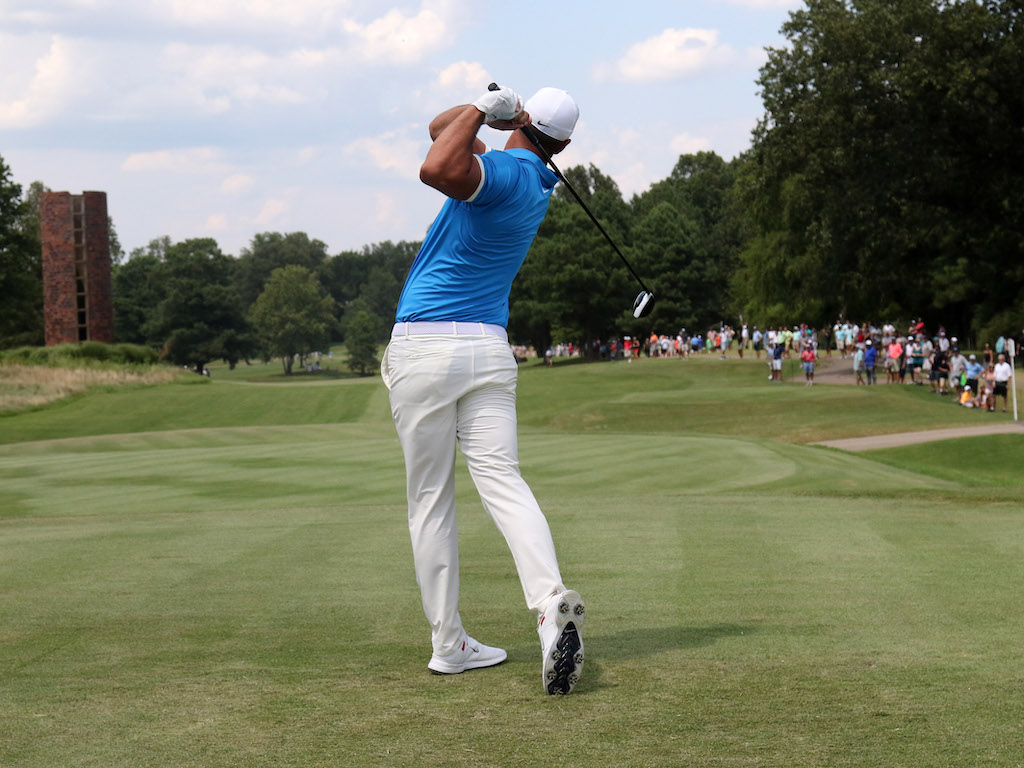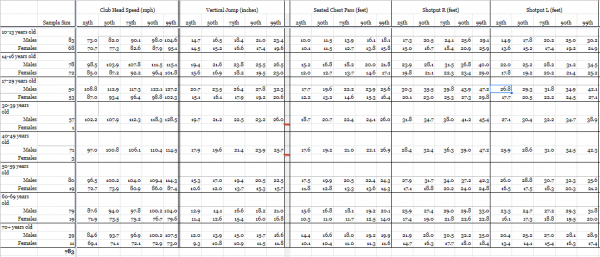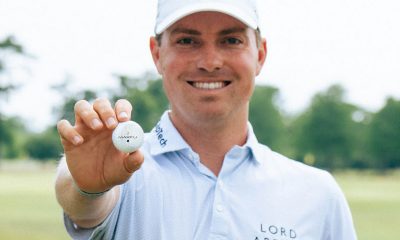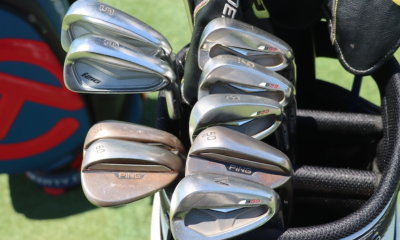Opinion & Analysis
Swing speed: How do you compare?

How fast a golfer swings the club has had an increasingly higher correlation to how much money the top PGA Tour professionals make in recent years—this is no secret.
What has been a secret, until now, is how fast other golfers your age swing and how you compare. No one has known, or if they have, they didn’t share it. We are going to reveal in this article, based on the research and data we have been collecting for over six years, where you stand compared to where you could be. No longer will you be held captive to father time and the belief that you are doomed to get worse with age!
After reading this article, you will see what is possible for you, depending on where you are in your golf life based on the cold, hard facts of science. The data sample we have is almost 800 golfers large and ranges from ages 10 to 80. The really cool thing about this article, though, is that we aren’t stopping there. We are then going to dive into the top three tests that you can do at home that correlate to clubhead speed at an incredibly high level.
If you find yourself in the 25th percentile for club speed but 90th percentile for the power tests, you have more speed in you right this second, we just have to get it out of you. It might be figuring out which of your four rotary centers are locked up or could be a simple nervous system fix such as over-speed training. All it takes is a simple assessment and application of the correct fix and you are good to go!
If, however, your swing speed is in the 75th percentile and your power numbers are only in the 25th percentile, you are swinging faster than your body can handle. The only way you are getting faster and minimizing the risk of injury is by improving your physical abilities.
You are likely already maximizing your equipment and technique as far as they will take you at this moment. Your low-hanging fruit is in either the mobility or the power quadrants of speed. This is again easily determined with a simple assessment so that you can apply the correct fix to your problem. If, however, you skipped the assessment and just started over-speed training or something other than what you actually needed, your likelihood for injury is probably quite high.
So let’s get into it…
STEP 1 – Power Assessment
The three tests that we measured in our research to look at their relationship to club speed were standing shot put from both sides (6 lb medicine ball), seated chest pass (6 lb medicine ball) and vertical jump. The correlations for each test to club speed for the entire sample are below. A correlation of 1.0 means that there is an exact relationship between the two variables, a correlation of 0.0 means there is absolutely no relationship. As you can see, vertical jump had the lowest correlation while shot put right (strong side) had the strongest correlation.
Shot Put R 0.822
Shot Put Left 0.809
Seated Chest Pass 0.802
Vertical Jump 0.644
For a more in-depth look at each test’s correlations to the club speed within each specific age group, I would encourage you to download the entire free report here.
Below are the charts for the power tests and their percentiles for each age group (click the image to expand)
Each of these tests is the first step for you to take to objectively assess where you are in terms of your ability to produce power. Complete each test, write down your numbers and then write down what percentile you fall into.
The next step is putting in your swing speed, assessing the relationship and then coming up with a plan.
Step 2 – Swing Speed Assessment
This is the one everyone is excited about. Find your age group bracket and see where you fall in the percentiles. Write this number and your percentile down and compare it to your power numbers. See anything interesting yet?
Swing Speed Data Table
| Percentiles | 25th | 50th | 75th | 90th | 99th |
| 10-13 years old | |||||
| Males | 73.0 | 82.0 | 90.1 | 98.0 | 104.6 |
| Females | 70.7 | 77.3 | 82.6 | 87.9 | 95.1 |
| 14-16 years old | |||||
| Males | 98.5 | 103.9 | 107.8 | 111.5 | 115.1 |
| Females | 85.0 | 87.2 | 92.2 | 96.4 | 101.8 |
| 17-29 years old | |||||
| Males | 108.8 | 112.9 | 117.3 | 122.1 | 127.2 |
| Females | 87.0 | 93.4 | 96.6 | 98.8 | 102.3 |
| 30-39 years old | |||||
| Males | 102.2 | 107.9 | 112.3 | 118.3 | 128.5 |
| Females | |||||
| 40-49 years old | |||||
| Males | 97.0 | 100.8 | 106.1 | 110.4 | 114.5 |
| Females | NA | NA | NA | NA | NA |
| 50-59 years old | |||||
| Males | 96.5 | 100.2 | 104.0 | 109.4 | 114.3 |
| Females | 72.7 | 73.9 | 80.9 | 86.0 | 87.4 |
| 60-69 years old | |||||
| Males | 87.6 | 94.0 | 97.8 | 100.2 | 104.0 |
| Females | 71.9 | 73.5 | 75.2 | 76.7 | 79.6 |
| 70+ years old | |||||
| Males | 84.6 | 93.7 | 96.9 | 100.2 | 107.5 |
| Females | 69.1 | 71.1 | 72.1 | 72.9 | 73.0 |
Step 3 – Asses Mobility
This is the most important step but also the least exciting. In order to complete step four, which is going to be coming up with your plan, you need to know how your mobility is at your four main rotary centers. Normally we charge $10 for this at-home assessment, but since you are reading it here at GolfWRX we are giving it to you for free.
Click here to download the free assessment.
Once you complete these simple mobility tests, we’ll give you the email to send your results to so we can send you some simple fixes complementary.
Write down your mobility results next to your power numbers, swing speeds and your percentiles for all categories. At this point, you should have a simple yet clear picture of you as a golfer.
Step 4 – Your Plan
This is where the magic happens. At this point, you have done more than 90 percent of golfers, golf instructors, and golf fitness gurus. You assessed objectively where you are today, all the major physical quadrants of your power profile. And it should not have taken you more than 15 minutes.
Now, look at all your numbers and first, identify any mobility restrictions you have. These are the most important ones to address first. Without question. Do the fixes we send you.
Next, take a look at your power percentiles vs. your club speed percentile.
Three Possible Outcomes
More RPM Under the Hood
If your power percentiles are higher than your speed percentile, you have more speed in your tank right this instant, we just need to let it out!
Fix any mobility restrictions you have and that will gain you speed. If you had no mobility restrictions, solutions such as over-speed training could be huge for you! That being said, avoid high volume protocols. We have found in some of our other research that you can gain the same speed numbers with a lot fewer swings. If you’re interested in learning more about these, stay tuned. I would also recommend looking at your equipment for ideal fit and your technique for maximal efficiency. Your solutions could lie in those areas as well.
The Ticking Time Bomb
If your power percentiles were lower than your speed percentile, you are swinging faster than your body wants to. You likely have optimized your equipment and technique to a degree. You are essentially defying nature. This sounds great until you understand the injury risk potential that exists for you.
Making sure your mobility is up to par is step one. If you want a sure-fire way to assure injury, swing faster than your body is capable of handling and do it without rotational mobility. Guaranteed poor outcome in that situation.
The next thing you need to do is get involved in a golf performance program of some sort that works on the specific areas of detriment that were identified in the power testing.
This doesn’t mean to start training the tests, however. This means that you should be implementing exercises and drills that train up the skills necessary to maximize power output in a pushing, rotational and vertical manner. Depending on your training experience and background, oftentimes seeking out help from a professional in designing this part of the solution is a wise move.
The Balanced Golfer
If you find that all your percentiles were pretty much the same, congratulations! You are a balanced golfer. As with the other two types, check your mobility and make sure you close any gaps there first. The next step for you will likely be a balance approach of technique, equipment, mobility, and strength conditioning for golf.
Once you figure out where you land, you likely will have questions about where to go next. Please don’t hesitate to reach out to us for complimentary calls to discuss your results and give you suggestions of what to do next.
Happy speed gains!
- LIKE147
- LEGIT18
- WOW7
- LOL2
- IDHT2
- FLOP5
- OB1
- SHANK58
19th Hole
Vincenzi’s LIV Golf Singapore betting preview: Course specialist ready to thrive once again

After another strong showing in Australia, LIV Golf will head to Sentosa Golf Club in Singapore looking to build off of what was undoubtedly their best event to date.
Sentosa Golf Club sits on the southern tip of Singapore and is one of the most beautiful courses in the world. The course is more than just incredible scenically; it was also rated 55th in Golf Digest’s top-100 courses in 2022-2023 and has been consistently regarded as one of the best courses in Asia. Prior to being part of the LIV rotation, the course hosted the Singapore Open every year since 2005.
Sentosa Golf Club is a par 71 measuring 7,406 yards. The course will require precise ball striking and some length off the tee. It’s possible to go low due to the pristine conditions, but there are also plenty of hazards and difficult spots on the course that can bring double bogey into play in a hurry. The Bermudagrass greens are perfectly manicured, and the course has spent millions on the sub-air system to keep the greens rolling fast. I spoke to Asian Tour player, Travis Smyth, who described the greens as “the best [he’s] ever played.”
Davis Love III, who competed in a Singapore Open in 2019, also gushed over the condition of the golf course.
“I love the greens. They are fabulous,” the 21-time PGA Tour winner said.
Love III also spoke about other aspects of the golf course.
“The greens are great; the fairways are perfect. It is a wonderful course, and it’s tricky off the tee.”
“It’s a long golf course, and you get some long iron shots. It takes somebody hitting it great to hit every green even though they are big.”
As Love III said, the course can be difficult off the tee due to the length of the course and the trouble looming around every corner. It will take a terrific ball striking week to win at Sentosa Golf Club.
In his pre-tournament press conference last season, Phil Mickelson echoed many of the same sentiments.
“To play Sentosa effectively, you’re going to have a lot of shots from 160 to 210, a lot of full 6-, 7-, 8-iron shots, and you need to hit those really well and you need to drive the ball well.”
Golfers who excel from tee to green and can dial in their longer irons will have a massive advantage this week.
Stat Leaders at LIV Golf Adelaide:
Fairways Hit
1.) Louis Oosthuizen
2.) Anirban Lahiri
3.) Jon Rahm
4.) Brendan Steele
5.) Cameron Tringale
Greens in Regulation
1.) Brooks Koepka
2.) Brendan Steele
3.) Dean Burmester
4.) Cameron Tringale
5.) Anirban Lahiri
Birdies Made
1.) Brendan Steele
2.) Dean Burmester
3.) Thomas Pieters
4.) Patrick Reed
5.) Carlos Ortiz
LIV Golf Individual Standings:
1.) Joaquin Niemann
2.) Jon Rahm
3.) Dean Burmester
4.) Louis Oosthuizen
5.) Abraham Ancer
LIV Golf Team Standings:
1.) Crushers
2.) Legion XIII
3.) Torque
4.) Stinger GC
5.) Ripper GC
LIV Golf Singapore Picks
Sergio Garcia +3000 (DraftKings)
Sergio Garcia is no stranger to Sentosa Golf Club. The Spaniard won the Singapore Open in 2018 by five strokes and lost in a playoff at LIV Singapore last year to scorching hot Talor Gooch. Looking at the course setup, it’s no surprise that a player like Sergio has played incredible golf here. He’s long off the tee and is one of the better long iron players in the world when he’s in form. Garcia is also statistically a much better putter on Bermudagrass than he is on other putting surfaces. He’s putt extremely well on Sentosa’s incredibly pure green complexes.
This season, Garcia has two runner-up finishes, both of them being playoff losses. Both El Camaleon and Doral are courses he’s had success at in his career. The Spaniard is a player who plays well at his tracks, and Sentosa is one of them. I believe Sergio will get himself in the mix this week. Hopefully the third time is a charm in Singapore.
Paul Casey +3300 (FanDuel)
Paul Casey is in the midst of one of his best seasons in the five years or so. The results recently have been up and down, but he’s shown that when he’s on a golf course that suits his game, he’s amongst the contenders.
This season, Casey has finishes of T5 (LIV Las Vegas), T2 (LIV Hong Kong), and a 6th at the Singapore Classic on the DP World Tour. At his best, the Englishman is one of the best long iron players in the world, which makes him a strong fit for Sentosa. Despite being in poor form last season, he was able to fire a Sunday 63, which shows he can low here at the course.
It’s been three years since Casey has won a tournament (Omega Dubai Desert Classic in 2021), but he’s been one of the top players on LIV this season and I think he can get it done at some point this season.
Mito Pereira +5000 (Bet365)
Since Mito Pereira’s unfortunate demise at the 2022 PGA Championship, he’s been extremely inconsistent. However, over the past few months, the Chilean has played well on the International Series as well as his most recent LIV start. Mito finished 8th at LIV Adelaide, which was his best LIV finish this season.
Last year, Pereira finished 5th at LIV Singapore, shooting fantastic rounds of 67-66-66. It makes sense why Mito would like Sentosa, as preeminent ball strikers tend to rise to the challenge of the golf course. He’s a great long iron player who is long and straight off the tee.
Mito has some experience playing in Asia and is one of the most talented players on LIV who’s yet to get in the winner’s circle. I have questions about whether or not he can come through once in contention, but if he gets there, I’m happy to roll the dice.
Andy Ogletree +15000 (DraftKings)
Andy Ogletree is a player I expected to have a strong 2024 but struggled early in his first full season on LIV. After failing to crack the top-25 in any LIV event this year, the former U.S. Amateur champion finally figured things out, finished in a tie for 3rd at LIV Adelaide.
Ogletree should be incredible comfortable playing in Singapore. He won the International Series Qatar last year and finished T3 at the International Series Singapore. The 26-year-old was arguably the best player on the Asian Tour in 2023 and has been fantastic in the continent over the past 18 months.
If Ogletree has indeed found form, he looks to be an amazing value at triple-digit odds.
- LIKE2
- LEGIT3
- WOW1
- LOL1
- IDHT0
- FLOP2
- OB0
- SHANK0
Opinion & Analysis
Ryan: Lessons from the worst golf instructor in America

In Tampa, there is a golf course that boasts carts that do not work, a water range, and a group of players none of which have any chance to break 80. The course is overseen by a staff of crusty men who have succeeded at nothing in life but ending up at the worst-run course in America. However, this place is no failure. With several other local courses going out of business — and boasting outstanding greens — the place is booked full.
While I came for the great greens, I stayed to watch our resident instructor; a poor-tempered, method teacher who caters to the hopeless. At first, it was simply hilarious. However, after months of listening and watching, something clicked. I realized I had a front-row seat to the worst golf instructor in America.
Here are some of my key takeaways.
Method Teacher
It is widely accepted that there are three types of golf instructors: system teachers, non-system teachers, and method teachers. Method teachers prescribe the same antidote for each student based on a preamble which teachers can learn in a couple day certification.
Method teaching allows anyone to be certified. This process caters to the lowest caliber instructor, creating the illusion of competency. This empowers these underqualified instructors with the moniker of “certified” to prey on the innocent and uninformed.
The Cult of Stack and Jilt
The Stack and Tilt website proudly boasts, “A golfer swings his hands inward in the backswing as opposed to straight back to 1) create power, similar to a field goal kicker moving his leg in an arc and 2) to promote a swing that is in-to-out, which produces a draw (and eliminates a slice).”
Now, let me tell you something, there is this law of the universe which says “energy can either be created or destroyed,” so either these guys are defying physics or they have no idea what they are taking about. Further, the idea that the first move of the backswing determines impact is conjecture with a splash of utter fantasy.
These are the pontifications of a method — a set of prescriptions applied to everyone with the hope of some success through the placebo effect. It is one thing for a naive student to believe, for a golf instructor to drink and then dispel this Kool-Aid is malpractice.
Fooled by Randomness
In flipping a coin, or even a March Madness bet, there is a 50-50 chance of success. In golf, especially for new players, results are asymmetric. Simply put: Anything can happen. The problem is that when bad instructors work with high handicappers, each and every shot gets its own diagnosis and prescription. Soon the student is overwhelmed.
Now here’s the sinister thing: The overwhelming information is by design. In this case, the coach is not trying to make you better, they are trying to make you reliant on them for information. A quasi Stockholm syndrome of codependency.
Practice
One of the most important scientists of the 20th century was Ivan Pavlov. As you might recall, he found that animals, including humans, could be conditioned into biological responses. In golf, the idea of practice has made millions of hackers salivate that they are one lesson or practice session from “the secret.”
Sunk Cost
The idea for the worst golf instructor is to create control and dependency so that clients ignore the sunk cost of not getting better. Instead, they are held hostage by the idea that they are one lesson or tip away from unlocking their potential.
Cliches
Cliches have the effect of terminating thoughts. However, they are the weapon of choice for this instructor. Add some hyperbole and students actually get no information. As a result, these players couldn’t play golf. When they did, they had no real scheme. With no idea what they are doing, they would descend into a spiral of no idea what to do, bad results, lower confidence, and running back to the lesson tee from more cliches.
The fact is that poor instruction is about conditioning players to become reliant members of your cult. To take away autonomy. To use practice as a form of control. To sell more golf lessons not by making people better but through the guise that without the teacher, the student can never reach their full potential. All under the umbrella of being “certified” (in a 2-day course!) and a melee of cliches.
This of course is not just happening at my muni but is a systemic problem around the country and around the world, the consequences of which are giving people a great reason to stop playing golf. But hey, at least it’s selling a lot of golf balls…
- LIKE15
- LEGIT1
- WOW0
- LOL3
- IDHT1
- FLOP0
- OB0
- SHANK12
19th Hole
Vincenzi’s 2024 Zurich Classic of New Orleans betting preview

The PGA TOUR heads to New Orleans to play the 2023 Zurich Classic of New Orleans. In a welcome change from the usual stroke play, the Zurich Classic is a team event. On Thursday and Saturday, the teams play best ball, and on Friday and Sunday the teams play alternate shot.
TPC Louisiana is a par 72 that measures 7,425 yards. The course features some short par 4s and plenty of water and bunkers, which makes for a lot of exciting risk/reward scenarios for competitors. Pete Dye designed the course in 2004 specifically for the Zurich Classic, although the event didn’t make its debut until 2007 because of Hurricane Katrina.
Coming off of the Masters and a signature event in consecutive weeks, the field this week is a step down, and understandably so. Many of the world’s top players will be using this time to rest after a busy stretch.
However, there are some interesting teams this season with some stars making surprise appearances in the team event. Some notable teams include Patrick Cantlay and Xander Schauffele, Rory McIlroy and Shane Lowry, Collin Morikawa and Kurt Kitayama, Will Zalatoris and Sahith Theegala as well as a few Canadian teams, Nick Taylor and Adam Hadwin and Taylor Pendrith and Corey Conners.
Past Winners at TPC Louisiana
- 2023: Riley/Hardy (-30)
- 2022: Cantlay/Schauffele (-29)
- 2021: Leishman/Smith (-20)
- 2019: Palmer/Rahm (-26)
- 2018: Horschel/Piercy (-22)
- 2017: Blixt/Smith (-27)
2024 Zurich Classic of New Orleans Picks
Tom Hoge/Maverick McNealy +2500 (DraftKings)
Tom Hoge is coming off of a solid T18 finish at the RBC Heritage and finished T13 at last year’s Zurich Classic alongside Harris English.
This season, Hoge is having one of his best years on Tour in terms of Strokes Gained: Approach. In his last 24 rounds, the only player to top him on the category is Scottie Scheffler. Hoge has been solid on Pete Dye designs, ranking 28th in the field over his past 36 rounds.
McNealy is also having a solid season. He’s finished T6 at the Waste Management Phoenix Open and T9 at the PLAYERS Championship. He recently started working with world renowned swing coach, Butch Harmon, and its seemingly paid dividends in 2024.
Keith Mitchell/Joel Dahmen +4000 (DraftKings)
Keith Mitchell is having a fantastic season, finishing in the top-20 of five of his past seven starts on Tour. Most recently, Mitchell finished T14 at the Valero Texas Open and gained a whopping 6.0 strokes off the tee. He finished 6th at last year’s Zurich Classic.
Joel Dahmen is having a resurgent year and has been dialed in with his irons. He also has a T11 finish at the PLAYERS Championship at TPC Sawgrass which is another Pete Dye track. With Mitchell’s length and Dahmen’s ability to put it close with his short irons, the Mitchell/Dahmen combination will be dangerous this week.
Taylor Moore/Matt NeSmith +6500 (DraftKings)
Taylor Moore has quickly developed into one of the more consistent players on Tour. He’s finished in the top-20 in three of his past four starts, including a very impressive showing at The Masters, finishing T20. He’s also finished T4 at this event in consecutive seasons alongside Matt NeSmith.
NeSmith isn’t having a great 2024, but has seemed to elevate his game in this format. He finished T26 at Pete Dye’s TPC Sawgrass, which gives the 30-year-old something to build off of. NeSmith is also a great putter on Bermudagrass, which could help elevate Moore’s ball striking prowess.
- LIKE8
- LEGIT3
- WOW1
- LOL1
- IDHT0
- FLOP3
- OB1
- SHANK2
-

 19th Hole1 week ago
19th Hole1 week agoJustin Thomas on the equipment choice of Scottie Scheffler that he thinks is ‘weird’
-

 19th Hole1 week ago
19th Hole1 week ago‘Absolutely crazy’ – Major champ lays into Patrick Cantlay over his decision on final hole of RBC Heritage
-

 19th Hole2 weeks ago
19th Hole2 weeks agoTwo star names reportedly blanked Jon Rahm all week at the Masters
-

 19th Hole2 weeks ago
19th Hole2 weeks agoReport: LIV Golf identifies latest star name they hope to sign to breakaway tour
-

 19th Hole2 weeks ago
19th Hole2 weeks agoNeal Shipley presser ends in awkward fashion after reporter claims Tiger handed him note on 8th fairway
-

 19th Hole2 weeks ago
19th Hole2 weeks agoBrandel Chamblee has ‘no doubt’ who started the McIlroy/LIV rumor and why
-

 Equipment3 weeks ago
Equipment3 weeks agoWhat we know about Bryson DeChambeau’s 3D-printed Avoda irons
-

 19th Hole5 days ago
19th Hole5 days agoLET pro gives detailed financial breakdown of first week on tour…and the net result may shock you

























des
Aug 9, 2019 at 2:14 pm
Why stop at 70? How about us 88 year olds.
Steve Pratt
Aug 8, 2019 at 12:35 am
Hey Chris,
I want to know if the correlation goes both ways.
If I train and improve my shot put/chest press/vertical leap numbers can I expect equal percentage gains in clubhead speed? Let’s say those are the only 3 exercises I do.
Patricknorm
Aug 7, 2019 at 10:26 am
I forgot the author’s name, but again people struggle with statistics and their interpretation. I under these charts and can’t really disagree with the numbers based on the number of tournaments I play each year and the broad spectrum of abilities I play with. For example two of my kids ( male and female) played elite hockey and their swing speeds are precisely correct in the upper speed ranges. I’m 65 and play tournament golf and I’m about average for distances and often out driven by much faster swingers.
I’ve had both knees replaced so, my vertical jump and leg strength is terrible. I know if I strength my legs I’ll hit my driver further. Easier said than done.
Brett
Aug 6, 2019 at 1:00 pm
Are these all scratch players? Watching club fittings I rarely see people as fast as your 50% category
Chris Finn
Aug 9, 2019 at 4:17 pm
Thesea are handicappers ranging from scratch to in the 20’s. The biggest thing to consider here is that the 50th and ups generally are involved in a golf performance program which increases their speed and power numbers. These is your normal country club golfer spectrum
Revanant
Aug 6, 2019 at 11:37 am
These numbers seem way out of proportion.
If I’m in my 20s and in average shape, I should have tour average swing speed?
Chris Finn
Aug 9, 2019 at 4:27 pm
“Average” shape in your 20’s would put you in the 105-113 range most likely. Remember, though, there are 4 main factors that impact speed (equipment, technique, mobility & power). From a physical standpoint, most “average” shape guys in their 20’s likely have the ability physically to swing this fast, but technique and power output coordination will likely keep them short. It is important to take note of this sample size that the 17-29 year old sample size is mostly Div 1 golfers and professionals.
Skeptic 123
Aug 6, 2019 at 8:31 am
I’m guessing that it is just a statistical anomaly that the 99th percentile swing speed for 70+ is higher than for a 60-69 yr old. 107 for a septuagenarian is pretty unbelievable.
Chris Finn
Aug 6, 2019 at 9:57 am
totally!
Pinhigh27
Aug 6, 2019 at 6:06 am
Sample population isn’t representative of average people, maybe high level golfers. Average for 17-29 is 113? Give me a break, maybe among good players. 90th percentile 122?
Your people are more likely to swing faster to begin with because they’re probably better players and looking to swing faster.
When talking about average persons potential you need to use data from average people, not a highly skilled subset.
Large chris
Aug 6, 2019 at 4:35 am
The comparison between power output and swing speed percentiles is useful definitely, but the absolute percentile swing speed figures are ridiculous.
These presumably are just test results of serious golfers who have been at your facility. No way the median 50% of male golfers in their thirties (of all golfers) is 108mph lol
Joe Frigo
Aug 6, 2019 at 6:23 am
lol totally agree with this! im 31 and my range is usually 108 – 112. When I play with my friends im definitely the fastest swing and the other 3 are around 100. optimal launch and spin being considered, that means half the men in their 30’s can potentially hit 300 yard drives
Large chris
Aug 6, 2019 at 7:43 am
And the top 1% (eg a million players if there are a hundred million male golfers in their thirties on the planet) are swinging at 128.5mph so they would all be longer than anyone on the PGA tour. BAHAHAHAHA.
Better explanation of who has been tested is required.
Joe Frigo
Aug 6, 2019 at 8:14 am
hahahaha seriously…. an explanation on who was tested is definitely needed!
I worked at a pga superstore and fitted for 3 years. I know my 108 – 112 avg isn’t the fastest by any means. but it was very very rare for someone to come in and swing faster than that
Chris Finn
Aug 6, 2019 at 10:00 am
tour average is 113 mph…exactly the same as our 17-29 year old demographics. The top tour players can swing in the high 120’s and some of the younger guys do top out in the 130′ if they go after it.
Chris Finn
Aug 6, 2019 at 10:02 am
the guys swinging in the 90-99th percentiles are not your average players, but the cool thing is that this data shows you what is possible at different ages and stages in the golf career.
Large chris
Aug 6, 2019 at 1:05 pm
Well the golfers in the 90-99% percentile should be the top 10% of all swing speeds for all golfers.
Not some undefined mysterious elite…. if this is a breakdown of mini tour players (figures still sound high) then please edit the article to say so.
Judge Smails
Aug 6, 2019 at 9:10 am
And there is no way that the median for 70+ is 94MPH. I remember Gary Player – one of the best athletes in the history of the game – saying his clubhead speed at age 75 was 93MPH. There are probably 50 super seniors at our club, and not one of us can get anywhere near 93. Most of us would be happy to hit 93MPH of BALL SPEED!
Chris Finn
Aug 6, 2019 at 10:04 am
This is just the average for 70 year olds who are participating in a targeted golf performance plan. most 70 year old golfers aren’t doing that which is why they don’t swing as fast. Hopefully this helps to give hope back to the guys in the 70’s who are in the 70’s and 80s mph that other guys are doing it and they likely can do better than where they are now.
Chris Finn
Aug 6, 2019 at 9:58 am
definitely the sample size is of golfers who are playing more than 4 times per year. These are players who practice and on average play 30ish times per year or more
MattM
Aug 5, 2019 at 11:39 pm
Sweet so I’m 99th percentile in all power categories just need to get the swing speed to catch up then.
Luke A Gentry
Aug 5, 2019 at 10:23 pm
When measuring the distances the medicine ball is thrown, do you include roll or mark the spot that it lands.
MattM
Aug 5, 2019 at 11:37 pm
Where it lands or else it would roll for days.
Chris Finn
Aug 6, 2019 at 10:01 am
great question! just mark the spot where it lands
Ashton
Aug 5, 2019 at 6:24 pm
I find myself in the 90th+ percentile in all categories except vertical leap.
I’d say that coincides directly with the amount of beer consumed and the waste size increasing.
I’d be curious if there’s another test that is more efficient than vertical leap – say leg press/squat.
What was the reasoning behind vertical leap? it takes into play the core and leg strength effectively, but would you say it also is a good indication of ability to fire the lower half in the swing?
Chris Finn
Aug 5, 2019 at 9:32 pm
Thanks for the read Ashton! Swing speed is an expression of power while squat and leg press are measures of strength…2 different but related physical skills. There is some research showing a weak relationship between squat and swing speed. The best relationship is actually based around how high you jump and how much you weigh. If a 100 lb person jumps 20″ and a 200lb person jump 20″ the heavier person is creating more power and will likely swing faster. We are currently building up our database with all that information, but this is a great start with the absolute data of just how high.